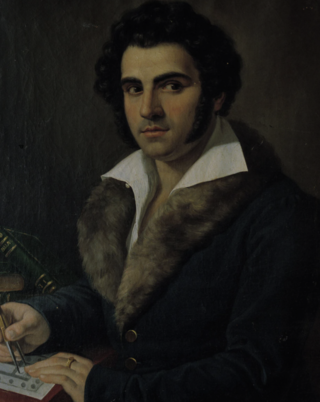Top Qs
Timeline
Chat
Perspective
Niccolò Matas
Italian architect (1798–1872) From Wikipedia, the free encyclopedia
Remove ads
Niccolò "Nicola" Matas (6 December 1798 – 11 March 1872)[1] was an Italian architect and professor. He is best known for being the architect of the 19th century Gothic Revival façade of the Basilica of Santa Croce in Florence, Italy.[2][3] Matas was a professor at the Academy of Fine Arts, Florence (Italian: Accademia di Belle Arti di Firenze).[1] He is one of the important architects in the history of the city of Florence.[1][4]
Remove ads
Biography
Summarize
Perspective
Early life
Niccolò "Nicola" Matas was born on 6 December 1798, in Ancona, in Marche, Papal States (now present-day Italy).[1] His family was Jewish and of Spanish descent.[1] He studied at Academy of Fine Arts, Rome (Italian: Accademia di Belle Arti di Roma); followed by study at the Academy of Fine Arts, Venice (Italian: Accademia di Belle Arti di Venezia) and the Academy of Fine Arts, Vicenza (Italian: Accademia di Belle Arti di Vicenza).
Career
In 1825, Matas moved to Florence, where he was an academic professor at the Academy of Fine Arts, Florence (Italian: Accademia di Belle Arti di Firenze), primarily teaching architecture.[1] His architect contemporaries in Tuscany included Gaetano Baccani, Mariano Falcini, Emilio De Fabris, and Giuseppe Poggi.[4] Matas worked closely with sculptor Giovanni Dupré of Gipsoteca Dupré.[4] He had a working relationship with Anatoly Demidov, 1st Prince of San Donato.[1]
From 1857 to 1863, he worked on the design of the façade of the Basilica of Santa Croce, where he worked in a prominent Star of David into the top of the building.[5][6] The design of the building was said to be influenced by a now-lost drawing by Simone del Pollaiolo, named "il Cronaca".[5] He is also thought to have been inspired by the Siena Cathedral (Italian: Duomo di Siena) and Orvieto Cathedral (Italian: Duomo di Orvieto).[7] At the same time he was working on the restoration (1851) of Santo Stefano dei Cavalieri, Pisa and the plan of the monumental cimitero delle Porte Sante (1848–59) at San Miniato al Monte, Florence (completed by Mariano Falcini).
Matas died in Florence on 11 March 1872.[1] His body was moved in 1886, and Matas is buried under the porch at the Basilica of Santa Croce.[1][8]
Remove ads
Works
New buildings or new portions of buildings
- 1835: Teatro delle Muse, Ancona, Marche, Italy. He worked on the building decorations.
- 1842: Dovizi Theater (Italian: Teatro dei Dovizi), Bibbiena, Tuscany, Italy[9]
- 1857–1863: façade of Santa Croce, Florence, Tuscany, Italy[10]
- 1851: Demidoff Gallery at Villa di San Martino, Elba Island, Portoferraio, province of Livorno, Italy[11][12]
- 1850–1855: Cimitero delle Porte Sante, near San Miniato al Monte, Florence, Italy
Restorations
- 1826: Bartolini Baldelli Palace (Italian: Palazzo Bartolini Baldelli), Florence, Tuscany, Italy. He restored the building.[13]
- 1834: Ancona Cathedral (Italian: Cattedrale di San Ciriaco), Ancona, Marche, Italy. He restored the building and the dome with copper.
- 1836: Palazzo Della Ripa, Florence, Tuscany, Italy. He restored the building.[1]
- Teatro delle Muse, Ancona
- Villa san Martino, Elba
- Façade of Santa Croce, Florence
Remove ads
References
External links
Wikiwand - on
Seamless Wikipedia browsing. On steroids.
Remove ads




